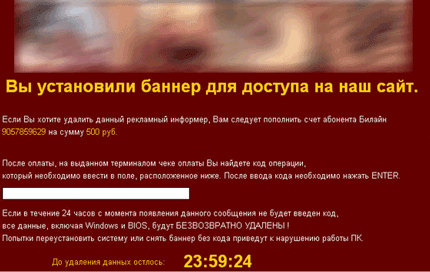TROJ_RANSOM.PRN
Windows 2000, Windows XP, Windows Server 2003


Threat Type: Trojan
Destructiveness: Yes
Encrypted: Yes
In the wild: Yes
OVERVIEW
This Trojan may be downloaded by other malware/grayware/spyware from remote sites. It may be dropped by other malware.
TECHNICAL DETAILS
Arrival Details
This Trojan may be downloaded by other malware/grayware/spyware from remote sites.
It may be dropped by other malware.
Installation
This Trojan drops the following non-malicious files:
- %User Profile%\r
(Note: %User Profile% is the current user's profile folder, which is usually C:\Windows\Profiles\{user name} on Windows 98 and ME, C:\WINNT\Profiles\{user name} on Windows NT, and C:\Documents and Settings\{user name} on Windows 2000, XP, and Server 2003.)
It drops the following copies of itself into the affected system:
- %User Profile%\{random characters}.exe
(Note: %User Profile% is the current user's profile folder, which is usually C:\Windows\Profiles\{user name} on Windows 98 and ME, C:\WINNT\Profiles\{user name} on Windows NT, and C:\Documents and Settings\{user name} on Windows 2000, XP, and Server 2003.)
Autostart Technique
This Trojan adds the following registry entries to enable its automatic execution at every system startup:
HKEY_CURRENT_USER\Software\Microsoft\
Windows\CurrentVersion\Run
{malware file name} = %User Profile%\{malware file name}.exe
Process Termination
This Trojan terminates the following processes if found running in the affected system's memory:
- taskmgr.exe
NOTES:
At first execution, the malware will restart the affected system.
After the machine restarts, it locks the Windows desktop and prompts the user to call a certain number and pay a ransom to receive a key. The system will be unusable until a key is entered correctly:
Based on its codes, the unlock code for this malware is “KVAS”.
SOLUTION
Step 1
For Windows XP and Windows Server 2003 users, before doing any scans, please make sure you disable System Restore to allow full scanning of your computer.
Step 2
Scan your computer with your Trend Micro product and note files detected as TROJ_RANSOM.PRN
Step 3
Restart in Safe Mode
Step 4
Search and delete this file
Step 5
Delete this registry value
Important: Editing the Windows Registry incorrectly can lead to irreversible system malfunction. Please do this step only if you know how or you can ask assistance from your system administrator. Else, check this Microsoft article first before modifying your computer's registry.
- In HKEY_CURRENT_USER\Software\Microsoft\Windows\CurrentVersion\Run
- {malware file name} = %User Profile%\{malware file name}.exe
- {malware file name} = %User Profile%\{malware file name}.exe
Step 6
Restart in normal mode and scan your computer with your Trend Micro product for files detected as TROJ_RANSOM.PRN. If the detected files have already been cleaned, deleted, or quarantined by your Trend Micro product, no further step is required. You may opt to simply delete the quarantined files. Please check this Knowledge Base page for more information.
Did this description help? Tell us how we did.



